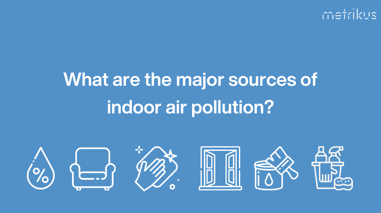Why is indoor air quality important in the workplace?
Indoor air quality monitoring in the workplace is an easy way to improve your bottom line, as well as the health and wellbeing of your employees.
Optimising your indoor air quality (IAQ) enhances employee wellbeing and productivity, which significantly impacts the success of your business. Staff spend an average 40 hours working per week, and now that COVID-19 has embedded a more flexible remote working culture into many organisations, it's crucial that these communal buildings provide a healthy and productive working environment.
What is indoor air quality monitoring in the workplace?
Indoor air quality monitoring in the workplace reports on levels of certain pollutants, such as CO2, PM2.5, and TVOCs, as well as humidity and temperature levels. Sensors are used to measure this data so it can be analysed, and action can be taken to improve the air quality in offices.
CO2: the silent enemy in the workplace
There is an abundance of scientific evidence that proves fresh air is necessary for optimal performance in the workplace. Employees who work in overcrowded offices or attend long meetings in poorly ventilated rooms are likely to experience high concentrations of carbon dioxide (CO2).
The effects of high levels of CO2:
- increased drowsiness
- 23% impairment in decision making.
- loss of concentration and impaired attention spans
- 11% reduction in productivity
Monitoring CO2 allows you to track key areas in real-time, and react appropriately to reduce elevated levels (in many places, opening a window is a start).
Keep your indoor air quality fresh
The impact buildings have on occupants’ health and wellbeing is now a concern for employees in the wake of the COVID-19 pandemic. Poor IAQ affects the overall health of your employees, which is directly reflected in absence rates. This happens because germs are disseminated much faster when air isn’t refreshed, increasing the spread of illnesses.
Temperature and humidity also play a vital role in the survival rate of viruses. Low humidity can cause mucous membranes to dry out, which compromises our body’s natural defence to viruses.
Investing in a good ventilation system and monitoring your indoor environment is a far more economical alternative to losing key team members for prolonged periods. The Office for National Statistics report showed that workplace absenteeism through sickness cost the UK economy 137 million working days in 2016, (equating to around £18 billion). Symptoms of Sick Building Syndrome (SBS), such as coughs and colds, were the most common reason for sickness absence. By monitoring workplace air quality, you can optimise working conditions by preventing SBS and stemming the transmission of viruses.
Photo by Alesia Kazantceva on Unsplash
Workplace wellness
It's clear that physical and mental wellbeing is now a top priority for employees: especially millennials, who currently make up 35% of the UK workforce. The vast majority of people now consider health and wellbeing offerings when choosing an employer, making it essential for both talent attraction and retention.
The Edmans Research Group also found that companies with high employee satisfaction outperformed their competitors by 2.3-3.8% per year. Environmental monitoring in your office is a great way to show that the wellbeing of your staff is something that matters to you.
Uncovering inefficiencies in your workplace
A final way in which monitoring indoor air quality can help your company is that it can help to uncover systemic inefficiencies in your building. For example, HVAC sensors may be incorrectly calibrated or your BMS could be poorly configured.
Occupancy levels in office spaces tend to average less than 55%, but lighting, heating, and building systems often run, despite the space being empty. Real-time air monitoring can ensure that energy is only used when required. This not only leads to significant cost savings but also brings about environmental benefits through a reduction in CO2 emissions.
The bottom line
There are numerous benefits of measuring and improving the indoor environment in your workplace. It is an extremely cost-effective way to optimise staff wellbeing and productivity, while improving your bottom line. Now is the time to make environmental monitoring a priority for your company!
If you're keen to read more about workplaces, take a look at our comprehensive PropTech Guide to Workplaces.





